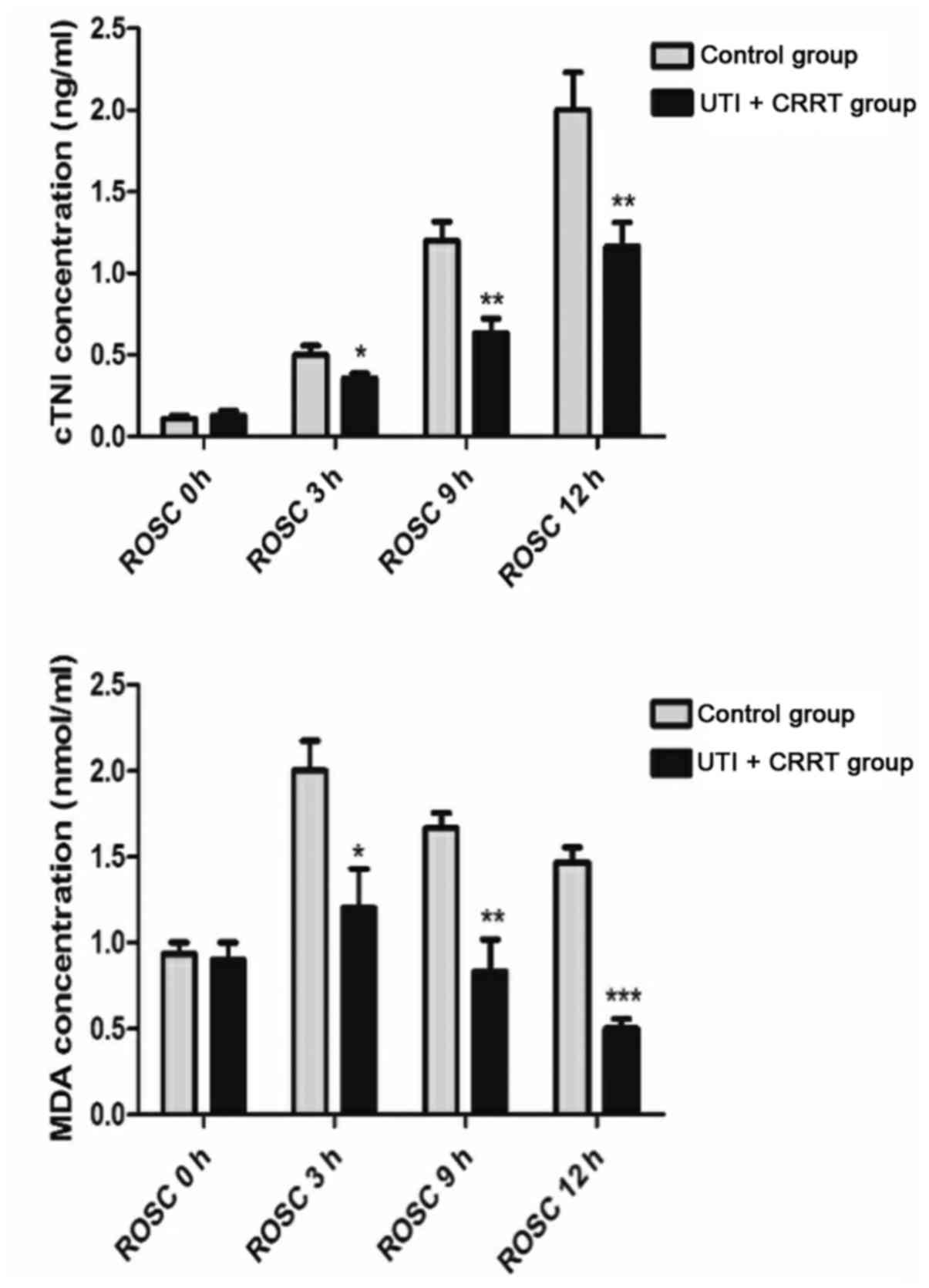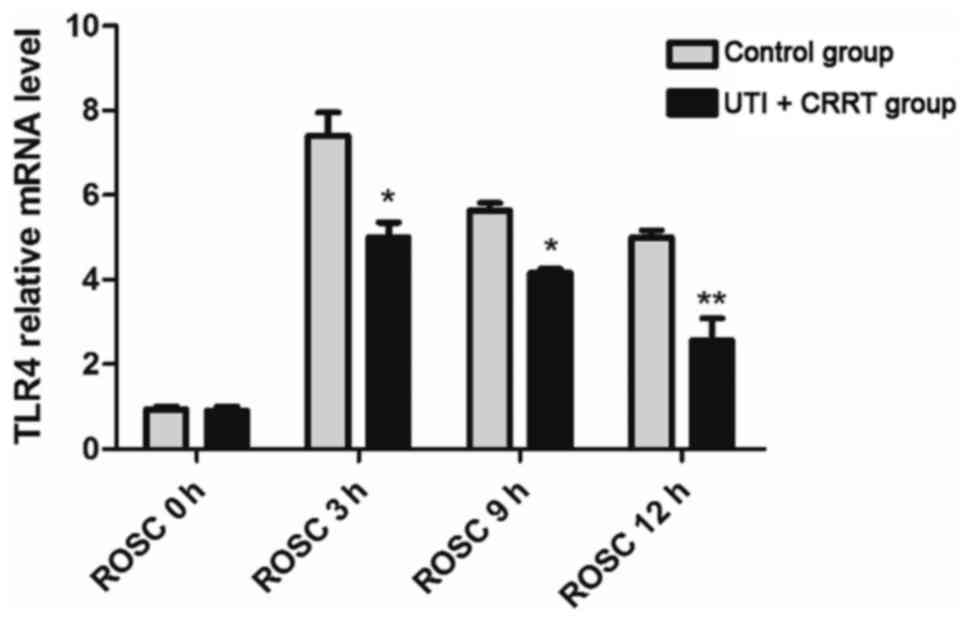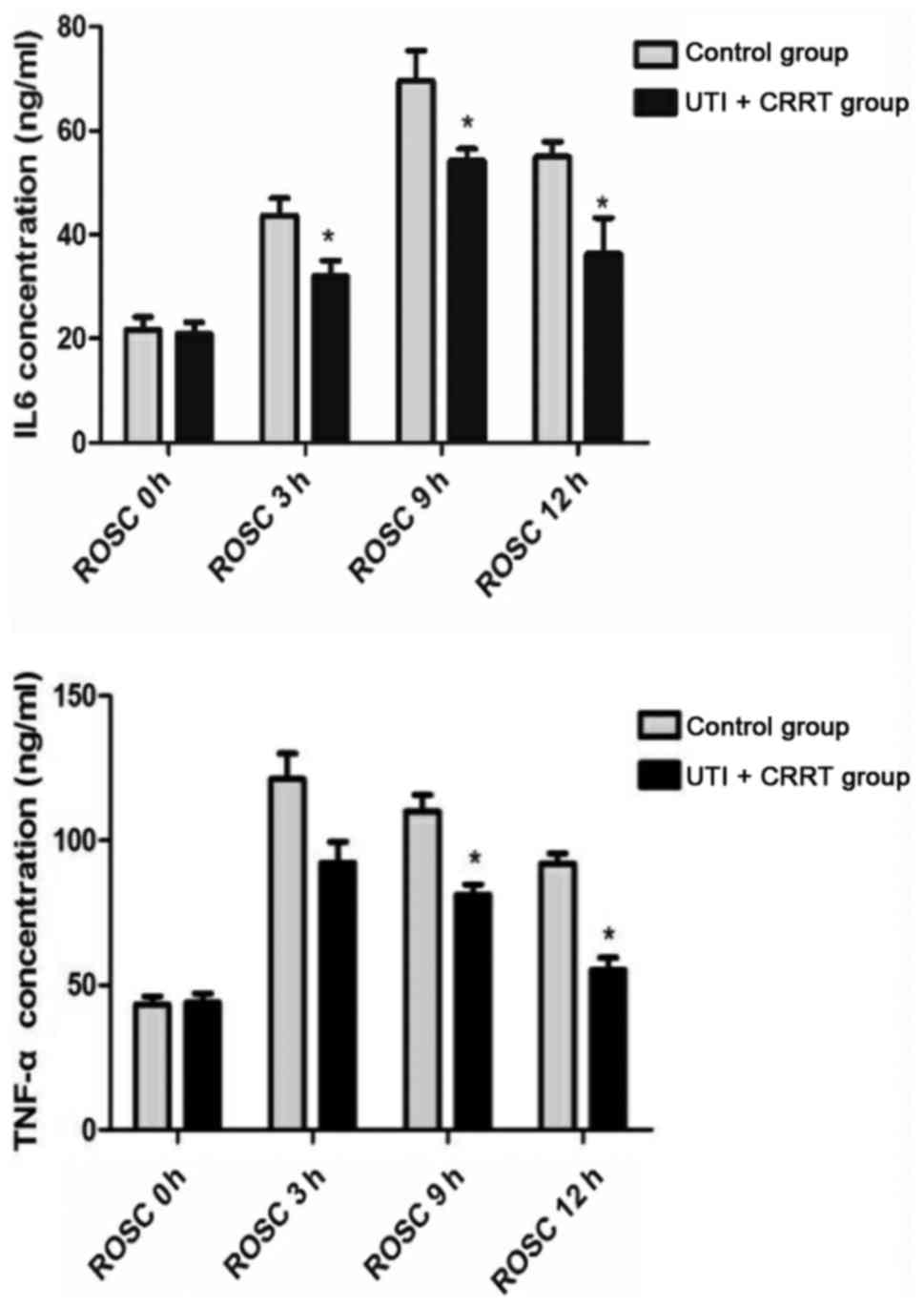Clinical observation of ulinastatin combined with CRRT in the treatment of early cardiopulmonary resuscitation
- Authors:
- Published online on: October 17, 2017 https://doi.org/10.3892/etm.2017.5325
- Pages: 6064-6068
-
Copyright: © Liu et al. This is an open access article distributed under the terms of Creative Commons Attribution License.
Abstract
Introduction
Sudden cardiac death is the leading cause of death in the world. Statistics show that in China, the number of sudden cardiac death per year is 544,000 (1). Cardiopulmonary resuscitation (CPR) is the most effective way to save the lives of patients. However, CPR still failed to achieve satisfactory results in the treatment of cardiac arrest (CA). The literature reported that 40% of patients undergoing CPR treatment achieved return of spontaneous circulation (ROSC), 10–30% of patients were completely cured and discharged, and the remaining patients died of disease (2). However, patients with successful rescue can often have a variety of complications, such as permanent neurological complications, including cognitive disorders and dyskinesia (3); post-resuscitation cardiac dysfunction is also an important reason leading to poor prognosis of patients (4), it manifests as systemic ischemia and reperfusion syndrome. At the same time, due to the sharp increase of a variety of deregulation cytokines in the blood 3 h after CA, such as endotoxin releasing into the plasma, there will be severe sepsis, leading to tissue damage (5–7). Therefore, it is of important clinical significance to explore an effective treatment in order to improve the CPR postoperative prognosis.
In this experiment, we selected ulinastatin (UTI). UTI is derived from human urinary protease inhibitors (8). It has been proved to have anti-inflammatory, inhibiting neutrophil elastase, inhibiting chemokine release and penetration effects (9). In addition, UTI protects mitochondrial function by reducing calcium overload in cells, playing a role in the protection of heart, lung, liver, kidney ischemia-reperfusion injury (10). However, few studies have evaluated the effect of UTI on cardiac dysfunction after CPR. In the present study, we adopted continuous renal replacement therapy (CRRT) at the same time, analyzed the role of UTI + CRRT in early CPR, to provide some theoretical basis for clinical treatment and improving the prognosis of CA.
Materials and methods
Clinical data
A total of 70 patients who were treated for CPR in Ganzhou People's Hospital from October 2016 to March 2017 were selected as the subjects. All patients or their families signed informed consent, all procedures were in accordance with the principles set out in the Helsinki Declaration. A total of 70 patients were randomly divided into control group (n=35, male 18, female 17, mean age: 53.71±5.41 years) and UTI combined with CRRT group (UTI + CRRT, n=35, male 19, female 16, mean age: 54.64±14.72 years). According to the American Heart Association guidelines, CPR was performed, if necessary, chest compression and defibrillation was given in reference to Advanced Cardiac Life Support Protocol. The study was approved by the Ethics Committee of Ganzhou People's Hospital.
Successful recovery was defined as patients showing significant pulse and electrocardiography rhythm as well as ventricular tachycardia or fibrillation. In the control group, patients were treated with conventional symptomatic therapy. In the UTI + CRRT group, patients were treated with intravenous injection of UTI immediately after ROSC (Guangdong Tianpu Biochemical Pharmaceutical Co., Ltd., Guangzhou, China; SFDA approval no. H9990134) (300,000 U dissolved in 20 ml NaCl solution), once every 12 h. At the same time, CRRT treatment was performed with Diapact CRRT (B. Braun Melsungen AG, Melsungen, Germany), 3 times for each patient: Once per day for 3 days, 8 h for each treatment. All patients underwent preoperative and post-resuscitation APACHE II scoring by the same physician.
Sample collection and testing
The whole blood samples of the patients were collected at 4 time points (0, 3, 6 and 12 h) after CPR. After collecting them in the sodium citrate anticoagulant tube, the cells were centrifuged for 5 min at 1,500 × g, then preserved at −80°C immediately. After all the samples were collected, tumor necrosis factor-α (TNF-α), IL-6, malondialdehyde (MDA) and cardiac troponin I (cTnI) were measured in all samples. Blood samples from patients were analyzed for pH, SO2, HCO3− and lactic acid (LAC) using i-STAT System 300 (Abbott Laboratories Inc., NY, USA). The cTnI concentration was measured using the Abbott AXSYM system. The MDA content was determined by the kit (Sigma; Merck KGaA, Darmstadt, Germany).
Detection of serum TNF-α and IL-6 by ELISA
The levels of TNF-α and IL-6 in the serum of the patients were determined by the ELISA kit (Abcam, Cambridge, MA, USA). The reaction was carried out according to the kit instructions. The reaction product was measured at 450 nm wavelength and the OD values were measured, the expression was analyzed.
Detection of toll-like receptor 4 (TLR4) expression by RT-PCR
The lymphocytes in the blood were extracted using the TBD lymphocyte extraction kit (Tiangen Biotech Co., Ltd., Beijing, China), and RNA was extracted using TRIzol reagent (Invitrogen; Thermo Fisher Scientific, Inc., Waltham, MA, USA). The concentration of extracted RNA was measured using a spectrophotometer, 1 µg of RNA was taken for reverse transcription (Takara Bio, Inc., Otsu, Japan). The mRNA levels of each indicators were determined using SYBR-Green fluorescent reagent (Toyobo Life Science, Osaka, Japan). TLR4 gene primers were synthesized by Sangon Biotech Shanghai Co., Ltd. (Shanghai, China). Sequences: Upstream 5′-CGTCTAGTCTAGAGCATCATC-3′; downstream 5′-GAGAAATGAGGAAGTAAGGG-3′; internal reference GAPDH: Upstream 5′-AGGTCGGTGTGAACGGATTTG-3′; downstream 5′-TGTAGACCATGTAGTTGAGGTCA-3′. The relative expression level of each index is 2-ΔCq [ΔCq = Cq (target gene) - Cq (GAPDH)].
Statistical analysis
The results were analyzed using GraphPad Prism software (Version 5.01; GraphPad Software, Inc., San Diego, Chile). The differences of the indicators between the two groups were compared by independent sample t-test. The expression of each indicator at four time points was measured using the variance analysis of repeated measurements. A P<0.05 was considered to indicate a statistically significant difference.
Results
The basic physiological variables of the control and the experimental group
There was no significant difference in body temperature, heart rate, mean arterial pressure, cardiac defibrillation and basic life support between the two groups (P>0.05) (Table I).
Evaluation of the difference between the biochemical indicators at different time points between the two groups of patients
The levels of pH and SaO2 in the two groups were not significantly different at any time point (P>0.05). Compared with the control group, the levels of HCO3− and LAC in the CRRT + UTI group was downregulated significantly at 3 h after ROSC (Table II).
Serum cTnI and plasma MDA expression
After CPR, the cTnI in the blood of the two groups showed a continuous upward trend, and MDA reached the peak at 3 h of ROSC. Starting from ROSC 3 h, UTI combined with CRRT significantly reduced the expression of cTnI and MDA (P<0.05) (Fig. 1).
RT-PCR detection of TLR4 mRNA levels
The patient's TLR4 mRNA expression reached the peak 3 h after the CPR, and then decreased. The expression levels of TLR4 mRNA in the CRRT + UTI group were lower than those in the control group at four time points (0, 3, 9, and ROSC 12 h) (P<0.05) (Fig. 2).
Detection of the expression of IL-6 and TNF-α by ELISA
After CPR, the levels of IL-6 and TNF-α in the blood of the two groups reached the peak at 9 h and 3 h of ROSC, respectively. However, the levels of IL-6 and TNF-α in UTI + CRRT were significantly lower than those in the control group (P<0.05) (Fig. 3).
Average recovery time of consciousness and spontaneous breathing after CPR
The average recovery time of consciousness and spontaneous breathing for the patients in UTI combined with CRRT was significantly shorter than the control group (P<0.05) (Table III).
APACHE II score of two groups
APACHE II scores were assessed by designated physicians before and 24 h after CPR. UTI combined with CRRT significantly reduced APACHE II scores (Table IV).
Discussion
After CA occurs in patients, it can lead to various pathological situations, such as inflammation, oxidative stress, myocardial damage and heart damage. In the present study, we analyzed multiple biomarkers at multiple time points after CPR treatment, including cTnI, MDA, TLR4, TNF-α, and IL-6. CTnI is a specific marker of myocardial injury (11). Early myocardial injury can be detected by serum cTnI levels (12). In the present study, serum cTnI was continuously elevated in both groups, but the level of UTI + CRRT was significantly lower than that of the control group. Changes in cTnI suggest that CA will inevitably lead to myocardial injury in patients, but the use of UTI + CRRT can reduce the damage to a certain extent.
It has been shown that oxidative stress is associated with lipid peroxidation and is one of the mechanisms of neuronal injury induced by ischemia-reperfusion (13,14). MDA, as the final product of lipid oxidation, can cause cross-linked polymerization of protein, nucleic acid and other macromolecules, and has cytotoxicity, it is often used as a marker of oxidative stress after ischemia-reperfusion (15,16). In the present study, plasma MDA levels in both groups increased significantly, reached a peak at 3 h after CPR treatment, and combination of UTI + CRRT significantly decreased MDA content, indicating that UTI and CRRT have protective effects on myocardium after CPR.
Organ damage CA after successful CRP is considered to associate with systemic inflammatory response; various cytokines and lipopolysaccharide (LPS) levels have been proved to have risen significantly in patients with successful resuscitation (17,18). TLR4 recognizes LPS, which promotes the production of a variety of inflammatory cytokines (IL-6 and TNF-α), leading to sepsis-like syndrome (19). Activated TLR4 promotes nuclear factor expression during cerebral ischemia and hypoxia, and induces the production of cytokines such as TNF-α and IL-6, causing inflammation and nerve damage (20). Therefore, we speculate that TLR4 signaling pathway may inhibit the inflammatory response and nerve damage by hypoxic preconditioning, thus protecting brain function. In addition, previous studies have shown that UTI can reduce lung and kidney damage caused by LPS inhibiting the inflammatory response of these organs (21). In this study, TLR4 gene was significantly upregulated in both groups after CPR, and TNF-α and IL-6 were also upregulated. UTI combined with CRRT significantly lowered these indicators and shortened the recovery time of consciousness and spontaneous breathing, reduced the APACHE II score.
In conclusion, we found that UTI combined with CRRT can protect against ischemia/reperfusion injury caused by early CPR, and can inhibit the inflammatory response induced by TLR4 after early CPR.
References
|
Zhang S: Sudden cardiac death in China: Current status and future perspectives. Europace. 17:14–18. 2015. View Article : Google Scholar | |
|
de Vreede-Swagemakers JJ, Gorgels AP, Dubois-Arbouw WI, van Ree JW, Daemen MJ, Houben LG and Wellens HJ: Out-of-hospital cardiac arrest in the 1990's: A population-based study in the Maastricht area on incidence, characteristics and survival. J Am Coll Cardiol. 30:1500–1505. 1997. View Article : Google Scholar : PubMed/NCBI | |
|
Peters R and Boyde M: Improving survival after in-hospital cardiac arrest: The Australian experience. Am J Crit Care. 16:240–246. 2007.PubMed/NCBI | |
|
Kim RJ, Wu E, Rafael A, Chen EL, Parker MA, Simonetti O, Klocke FJ, Bonow RO and Judd RM: The use of contrast-enhanced magnetic resonance imaging to identify reversible myocardial dysfunction. N Engl J Med. 343:1445–1453. 2000. View Article : Google Scholar : PubMed/NCBI | |
|
Carden DL and Granger DN: Pathophysiology of ischaemia-reperfusion injury. J Pathol. 190:255–266. 2000. View Article : Google Scholar : PubMed/NCBI | |
|
Hernandez LA and Grisham MB: Role of neutrophils in ischemia reperfusion induced microvascular injury. Am J Physiol Heart Circ Physiol. 3:699–703. 2006. | |
|
Hausenloy DJ and Yellon DM: Myocardial ischemia-reperfusion injury: A neglected therapeutic target. J Clin Invest. 123:92–100. 2013. View Article : Google Scholar : PubMed/NCBI | |
|
Koga Y, Fujita M, Tsuruta R, Koda Y, Nakahara T, Yagi T, Aoki T, Kobayashi C, Izumi T, Kasaoka S, et al: Urinary trypsin inhibitor suppresses excessive superoxide anion radical generation in blood, oxidative stress, early inflammation, and endothelial injury in forebrain ischemia/reperfusion rats. Neurol Res. 32:925–932. 2010. View Article : Google Scholar : PubMed/NCBI | |
|
Wang G, Wen J, Wilbur RR, Wen P, Zhou SF and Xiao X: The effect of somatostatin, ulinastatin and Salvia miltiorrhiza on severe acute pancreatitis treatment. Am J Med Sci. 346:371–376. 2013. View Article : Google Scholar : PubMed/NCBI | |
|
Pang XY, Fang CC, Chen YY, Liu K and Song GM: Effects of ulinastatin on perioperative inflammatory response and pulmonary function in cardiopulmonary bypass patients. Am J Ther. 23:e1680–e1689. 2016. View Article : Google Scholar : PubMed/NCBI | |
|
Kruzan RM, Herzog CA, Wu A, Sang Y, Parekh RS, Matsushita K, Hwang S, Cheng A, Coresh J, Powe NR, et al: Association of NTproBNP and cTnI with outpatient sudden cardiac death in hemodialysis patients: The choices for healthy outcomes in caring for ESRD (CHOICE) study. BMC Nephrol. 17:182016. View Article : Google Scholar : PubMed/NCBI | |
|
Hu CL, Wei HY, Liu ZY, Li X, Liao XX, Li YJ, Zhan H, Jing XL, Xiong Y, Liu YY, et al: Investigation of the relationship between venticular fibrillation duration and cardiac/neurological damage in a rabbit model of electrically induced arrhythmia. J Trauma. 69:1442–1447. 2010. View Article : Google Scholar : PubMed/NCBI | |
|
Murdolo G, Piroddi M, Luchetti F, Tortoioli C, Canonico B, Zerbinati C, Galli F and Iuliano L: Oxidative stress and lipid peroxidation by-products at the crossroad between adipose organ dysregulation and obesity-linked insulin resistance. Biochimie. 95:585–594. 2013. View Article : Google Scholar : PubMed/NCBI | |
|
Martindale JJ and Metzger JM: Uncoupling of increased cellular oxidative stress and myocardial ischemia reperfusion injury by directed sarcolemma stabilization. J Mol Cell Cardiol. 67:26–37. 2014. View Article : Google Scholar : PubMed/NCBI | |
|
Li XY and Chow CK: An improved method for the measurement of malondialdehyde in biological samples. Lipids. 29:73–75. 1994. View Article : Google Scholar : PubMed/NCBI | |
|
Esterbauer H, Schaur RJ and Zollner H: Chemistry and biochemistry of 4-hydroxynonenal, malonaldehyde and related aldehydes. Free Radic Biol Med. 11:81–128. 1991. View Article : Google Scholar : PubMed/NCBI | |
|
Neumar RW, Nolan JP, Adrie C, Aibiki M, Berg RA, Böttiger BW, Callaway C, Clark RS, Geocadin RG, Jauch EC, et al: Post-cardiac arrest syndrome: Epidemiology, pathophysiology, treatment, and prognostication. A consensus statement from the International Liaison Committee on Resuscitation (American Heart Association, Australian and New Zealand Council on Resuscitation, European Resuscitation Council, Heart and Stroke Foundation of Canada, InterAmerican Heart Foundation, Resuscitation Council of Asia, and the Resuscitation Council of Southern Africa); the American Heart Association Emergency Cardiovascular Care Committee; the Council on Cardiovascular Surgery and Anesthesia; the Council on Cardiopulmonary, Perioperative, and Critical Care; the Council on Clinical Cardiology; and the Stroke Council. Circulation. 118:2452–2483. 2008. View Article : Google Scholar : PubMed/NCBI | |
|
Erenler AK, Çelik S, Baydin A, Tomak L, KoSargelir M and Yasti AÇ: Outcomes of cardiopulmonary resuscitation in trauma patients in the emergency department. Eur Rev Med Pharmacol Sci. 19:2567–2571. 2015.PubMed/NCBI | |
|
Janssen E, Ozcan E, Liadaki K, Jabara HH, Manis J, Ullas S, Akira S, Fitzgerald KA, Golenbock DT and Geha RS: TRIF signaling is essential for TLR4-driven IgE class switching (IRM5P. 707). J Immunol. 192:2651–2658. 2014. View Article : Google Scholar : PubMed/NCBI | |
|
Blanco AM, Vallés SL, Pascual M and Guerri C: Involvement of TLR4/type I IL-1 receptor signaling in the induction of inflammatory mediators and cell death induced by ethanol in cultured astrocytes. J Immunol. 175:6893–6899. 2005. View Article : Google Scholar : PubMed/NCBI | |
|
Chen J, Wang J, Su C, Qian W, Sun L, Sun H, Chen J, Zhang H and Zhang J: Urinary trypsin inhibitor attenuates LPS-induced endothelial barrier dysfunction by upregulation of vascular endothelial-cadherin expression. Inflamm Res. 65:213–224. 2016. View Article : Google Scholar : PubMed/NCBI |












